Ag Behavior on TiN Thin Films for Decorative Coatings
Abstract
:1. Introduction
2. Experimental Section
2.1. Deposition of TiN-Ag Coatings
2.2. Characterization of TiN-Ag Coatings
3. Results and Discussion
3.1. XRD Patterns of TiN-Ag Films
3.2. Composition, Microstructure and Morphology of TiN-Ag Coatings
3.3. The Roughness—RMS and Thickness of TiN-Ag Coatings
3.4. Wettability (Contact Angle)
3.5. The L, a*, b* Color Space Analysis
3.6. Salt Spray Analysis
4. Conclusions
Author Contributions
Funding
Institutional Review Board Statement
Informed Consent Statement
Data Availability Statement
Acknowledgments
Conflicts of Interest
References
- Sola, R.; Veronesi, P.; Zardin, B.; Borghi, M. A Study on PVD Coatings for Reduction of Friction and Wear of Swashplate Axial Piston Pumps and Motors. Metall. Ital. 2020, 112, 14–23. [Google Scholar]
- Santecchia, E.; Hamouda, A.M.S.; Musharavati, F.; Zalnezhad, E.; Cabibbo, M.; Spigarelli, S. Wear Resistance Investigation of Titanium Nitride-Based Coatings. Ceram. Int. 2015, 41, 10349–10379. [Google Scholar] [CrossRef]
- Silva, F.; Martinho, R.; Andrade, M.; Baptista, A.; Alexandre, R. Improving the Wear Resistance of Moulds for the Injection of Glass Fibre-Reinforced Plastics Using PVD Coatings: A Comparative Study. Coatings 2017, 7, 28. [Google Scholar] [CrossRef]
- Van Stappen, M.; Stals, L.M.; Kerkhofs, M.; Quaeyhaegens, C. State of the Art for the Industrial Use of Ceramic PVD Coatings. Surf. Coat. Technol. 1995, 74, 629–633. [Google Scholar] [CrossRef]
- Arrousse, N.; Ferreira, J.; Carvalho, S.; Andritschky, M. PVD Black Coating for Decorative Applications. Coatings 2023, 13, 1838. [Google Scholar] [CrossRef]
- Vorobyova, M.; Biffoli, F.; Giurlani, W.; Martinuzzi, S.M.; Linser, M.; Caneschi, A.; Innocenti, M. PVD for Decorative Applications: A Review. Materials 2023, 16, 4919. [Google Scholar] [CrossRef]
- Fortune Business Insights Physical—Vapor Deposition (PVD) Market Size & Growth 2023–2028. Page. Available online: https://www.fortunebusinessinsights.com/physical-vapour-deposition-pvd-market-102364 (accessed on 14 January 2024).
- Arul, S.; Easwaramoorthi, M.; Meikandan, M. Different Types of PVD Coatings and Their Demands—A Review. Int. J. Appl. Eng. Res. 2014, 9, 26417–26430. [Google Scholar]
- Popović, M.; Novaković, M.; Vaňa, D.; Ronning, C.; Jugović, D.; Rajić, V.; Noga, P. Structure-Dependent Optical Properties of Au/Ag Irradiated TiN Thin Films. Opt. Mater. 2023, 138, 113684. [Google Scholar] [CrossRef]
- Novaković, M.; Popović, M.; Noga, P.; Vaňa, D.; Ronning, C. Low Optical Losses in Plasmonic TiN Thin Films Implanted with Silver and Gold. Opt. Mater. 2022, 123, 111936. [Google Scholar] [CrossRef]
- Chouirfa, H.; Bouloussa, H.; Migonney, V.; Falentin-Daudré, C. Review of Titanium Surface Modification Techniques and Coatings for Antibacterial Applications. Acta Biomater. 2019, 83, 37–54. [Google Scholar] [CrossRef]
- Chen, N.H.; Chung, C.J.; Chiang, C.C.; Chen, K.C.; He, J.L. Antimicrobial Copper-Containing Titanium Nitride Coatings Co-Deposited by Arc Ion Plating/Magnetron Sputtering for Protective and Decorative Purposes. Surf. Coat. Technol. 2014, 253, 83–88. [Google Scholar] [CrossRef]
- Chen, Z.; Wang, Z.; Qiu, W.; Fang, F. Overview of Antibacterial Strategies of Dental Implant Materials for the Prevention of Peri-Implantitis. Bioconjug. Chem. 2021, 32, 627–638. [Google Scholar] [CrossRef]
- Osés, J.; Fuentes, G.G.; Palacio, J.F.; Esparza, J.; García, J.A.; Rodríguez, R. Antibacterial Functionalization of PVD Coatings on Ceramics. Coatings 2018, 8, 197. [Google Scholar] [CrossRef]
- Sarraf, M.; Dabbagh, A.; Abdul Razak, B.; Nasiri-Tabrizi, B.; Hosseini, H.R.M.; Saber-Samandari, S.; Abu Kasim, N.H.; Yean, L.K.; Sukiman, N.L. Silver Oxide Nanoparticles-Decorated Tantala Nanotubes for Enhanced Antibacterial Activity and Osseointegration of Ti6Al4V. Mater. Des. 2018, 154, 28–40. [Google Scholar] [CrossRef]
- Cloutier, M.; Mantovani, D.; Rosei, F. Antibacterial Coatings: Challenges, Perspectives, and Opportunities. Trends Biotechnol. 2015, 33, 637–652. [Google Scholar] [CrossRef]
- Mesbah, M.; Sarraf, M.; Dabbagh, A.; Nasiri-Tabrizi, B.; Paria, S.; Banihashemian, S.M.; Bushroa, A.R.; Faraji, G.; Tsuzuki, T.; Madaah Hosseini, H.R. Synergistic Enhancement of Photocatalytic Antibacterial Effects in High-Strength Aluminum/TiO2 Nanoarchitectures. Ceram. Int. 2020, 46, 24267–24280. [Google Scholar] [CrossRef]
- Liu, H.; Battiato, S.; Pellegrino, A.L.; Paoli, P.; Rossi, P.; Jiménez, C.; Malandrino, G.; Muñoz-Rojas, D. Deposition of Metallic Silver Coatings by Aerosol Assisted MOCVD Using Two New Silver β-Diketonate Adduct Metalorganic Precursors. Dalton Trans. 2017, 46, 10986–10995. [Google Scholar] [CrossRef]
- Braceras, I.; Brizuela, M.; Álvarez, N.; Martínez Van Geeteruyen, M.; Azkona, I. TiN-Ag as an Antimicrobial and Wear Resistant Coating. Biotribology 2021, 28, 100192. [Google Scholar] [CrossRef]
- Marques, S.M.; Carvalho, I.; Leite, T.R.; Henriques, M.; Carvalho, S. Antimicrobial TiN-Ag Coatings in Leather Insole for Diabetic Foot. Materials 2022, 15, 2009. [Google Scholar] [CrossRef] [PubMed]
- Kelly, P.J.; Li, H.; Whitehead, K.A.; Verran, J.; Arnell, R.D.; Iordanova, I. A Study of the Antimicrobial and Tribological Properties of TiN/Ag Nanocomposite Coatings. Surf. Coat. Technol. 2009, 204, 1137–1140. [Google Scholar] [CrossRef]
- Du, D.; Liu, D.; Zhang, X.; Tang, J.; Xiang, D. Characterization and Mechanical Properties Investigation of TiN-Ag Films onto Ti-6Al-4V. Appl. Surf. Sci. 2016, 365, 47–56. [Google Scholar] [CrossRef]
- JIS Z 2801; Antibacterial Products–Test for Antibacterial Activity and Efficacy. Japanese Industrial Standard: Tokyo, Japan, 2012.
- Owens, D.K.; Wendt, R.C. Estimation of the surface free energy of polymers. J. Appl. Polym. 1969, 13, 1741–1747. [Google Scholar] [CrossRef]
- Skowroński, Ł.; Antończak, A.J.; Trzcinski, M.; Łazarek, Ł; Hiller, T.; Bukaluk, A.; Wronkowska, A.A. Optical Properties of Laser Induced Oxynitride Films on Titanium. Appl. Surf. Sci. 2014, 304, 107–114. [Google Scholar] [CrossRef]
- Klein, G.A. Springer Series in Optical Sciences 154 Industrial Color Physics; Springer: Berlin/Heidelberg, Germany, 2011. [Google Scholar]
- Pandey, A.; Dalal, S.; Dutta, S.; Dixit, A. Structural Characterization of Polycrystalline Thin Films by X-Ray Diffraction Techniques. J. Mater. Sci. Mater. Electron. 2021, 32, 1341–1368. [Google Scholar] [CrossRef]
- Ju, H.; Yu, L.; Yu, D.; Asempah, I.; Xu, J. Microstructure, Mechanical and Trobological Properties of TiN-Ag Films Deposited by Reactive Magnetron Sputtering. Vacuum 2017, 141, 82–88. [Google Scholar] [CrossRef]
- Wasa, K. 2-Sputtering Phenomena. In Handbook of Sputtering Technology, 2nd ed.; Wasa, K., Kanno, I., Kotera, H., Eds.; William Andrew Publishing: Oxford, UK, 2012; pp. 41–75. ISBN 978-1-4377-3483-6. [Google Scholar]
- Kışla, D.; Gökmen, G.G.; Akdemir Evrendilek, G.; Akan, T.; Vlčko, T.; Kulawik, P.; Režek Jambrak, A.; Ozogul, F. Recent Developments in Antimicrobial Surface Coatings: Various Deposition Techniques with Nanosized Particles, Their Application and Environmental Concerns. Trends Food Sci. Technol. 2023, 135, 144–172. [Google Scholar] [CrossRef]
- Calderon Velasco, S.; Cavaleiro, A.; Carvalho, S. Functional Properties of Ceramic-Ag Nanocomposite Coatings Produced by Magnetron Sputtering. Prog. Mater. Sci. 2016, 84, 158–191. [Google Scholar] [CrossRef]
- Ning, Z.; Wang, Y.; Li, S.; Tang, K.; Wen, M. The Sputtering Performance of Ag Sputtering Targets with Different Microstructure. Vacuum 2023, 210, 111888. [Google Scholar] [CrossRef]
- Marmur, A.; Volpe, C.D.; Siboni, S.; Amirfazli, A.; Drelich, J.W. Contact Angles and Wettability: Towards Common and Accurate Terminology. Surf. Innov. 2017, 5, 3–8. [Google Scholar] [CrossRef]
- Lugscheider, E.; Bobzin, K. Wettability of PVD Compound Materials by Lubricants. Surf. Coat. Technol. 2003, 165, 51–57. [Google Scholar] [CrossRef]
- Yuan, Y.; Lee, T.R. Contact Angle and Wetting Properties. In Surface Science Techniques; Springer Series in Surface Sciences; Springer: Berlin/Heidelberg, Germany, 2013; Volume 51, pp. 3–34. [Google Scholar] [CrossRef]
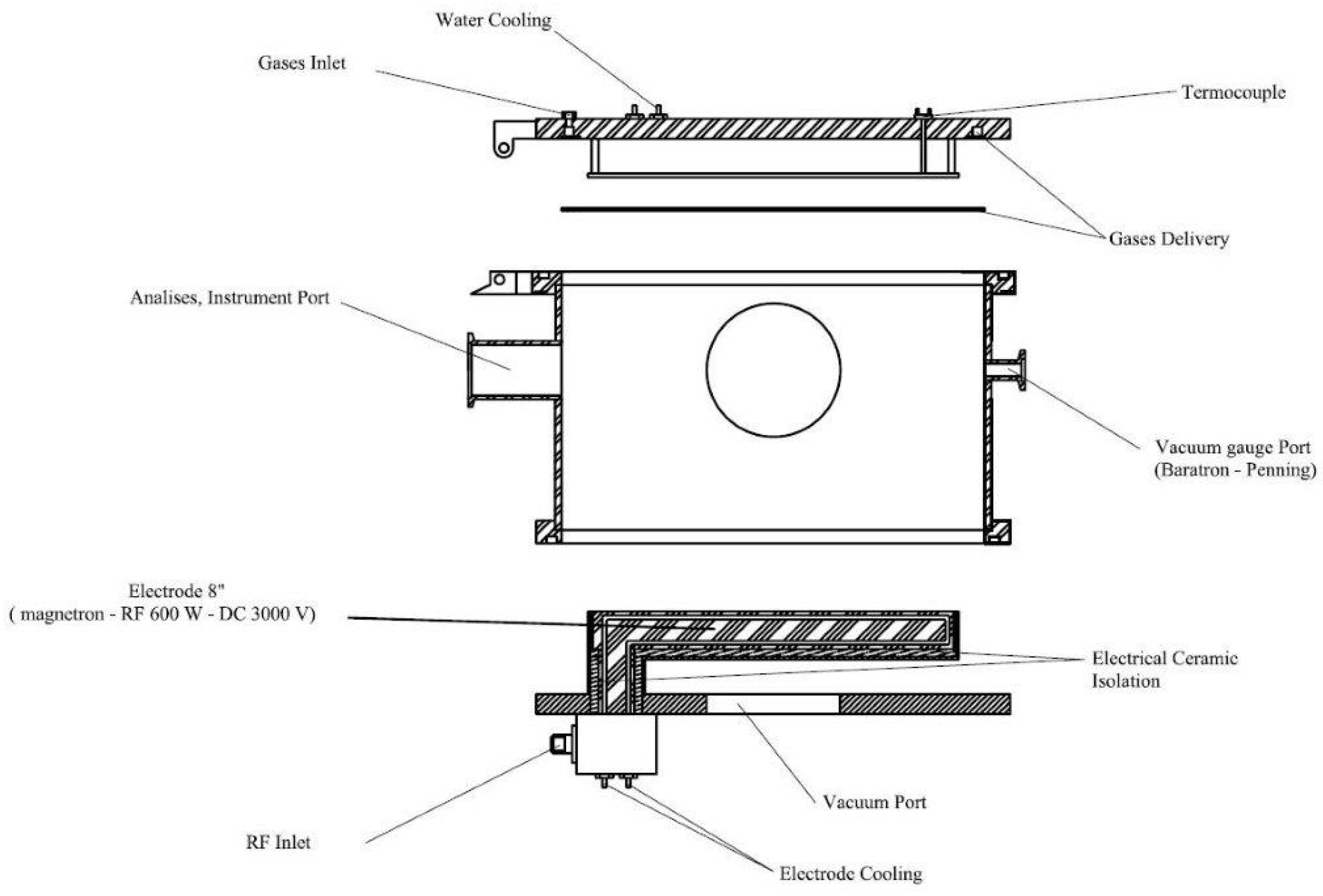
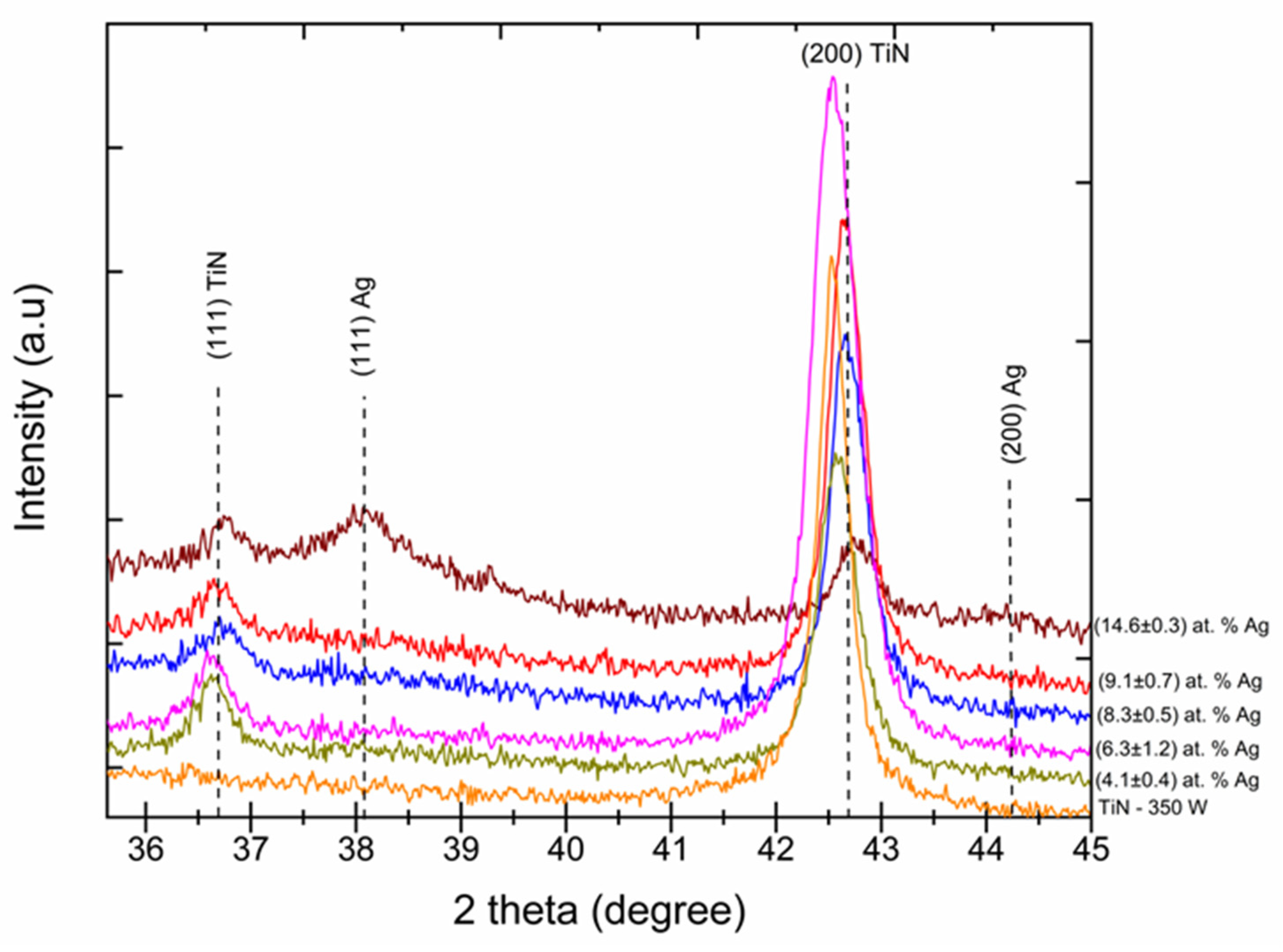
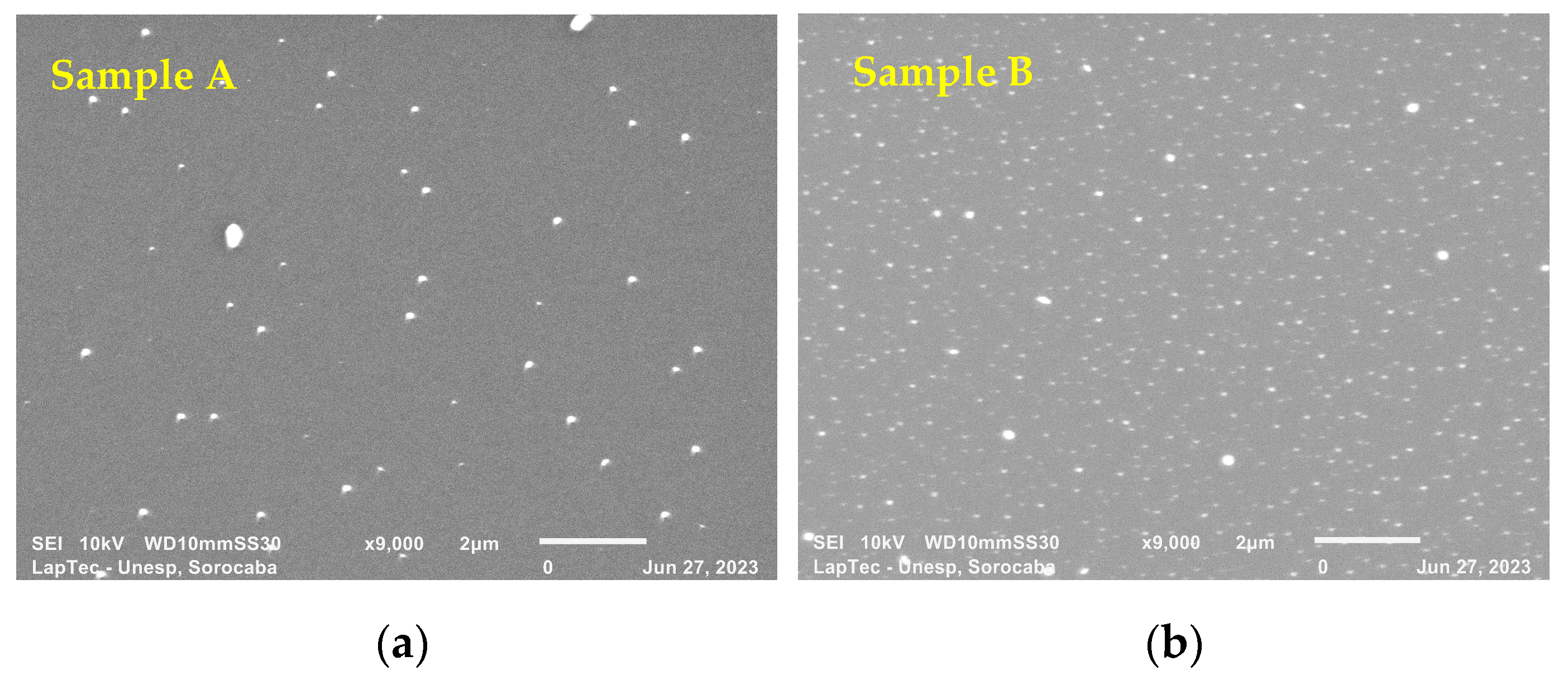
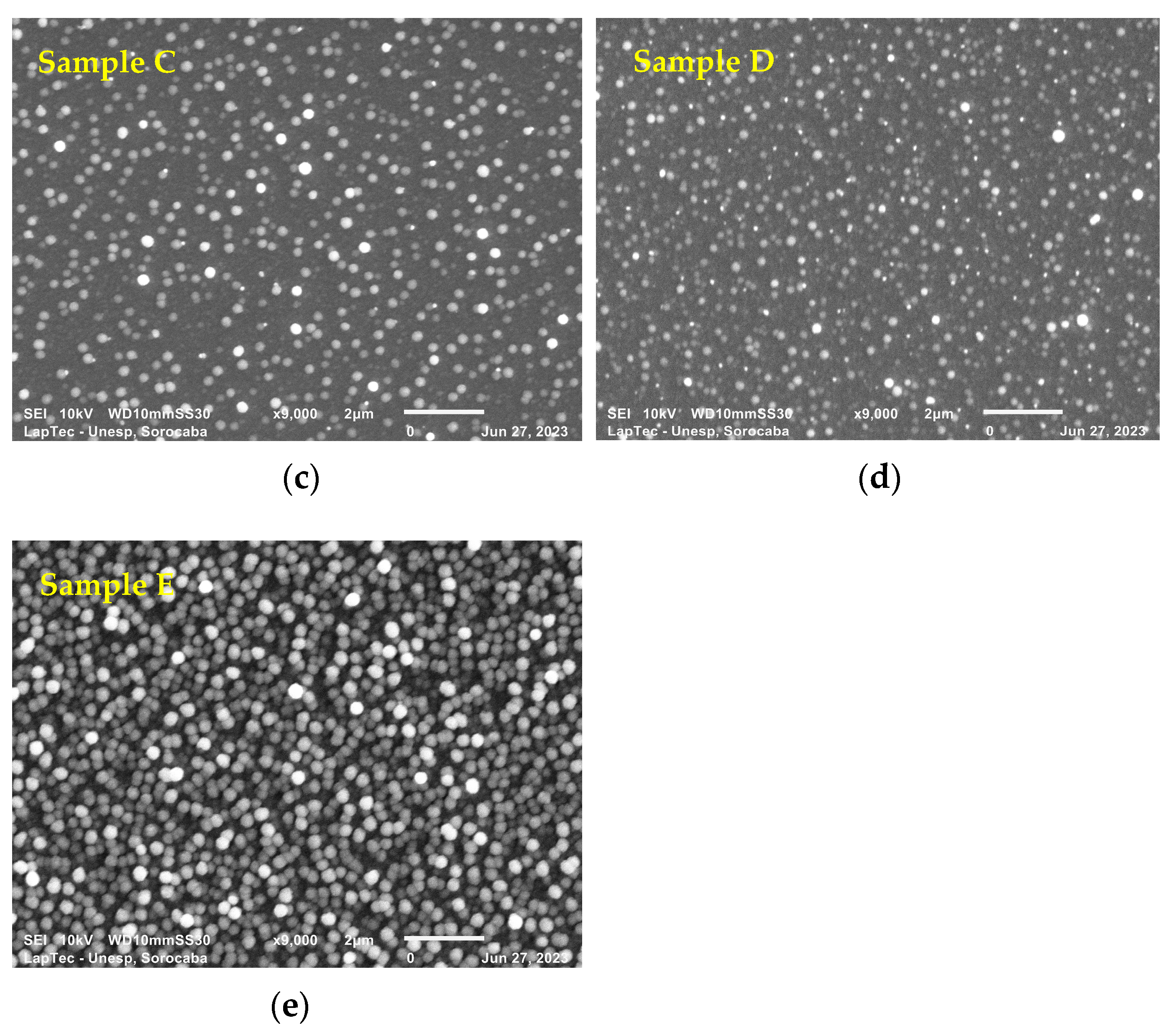
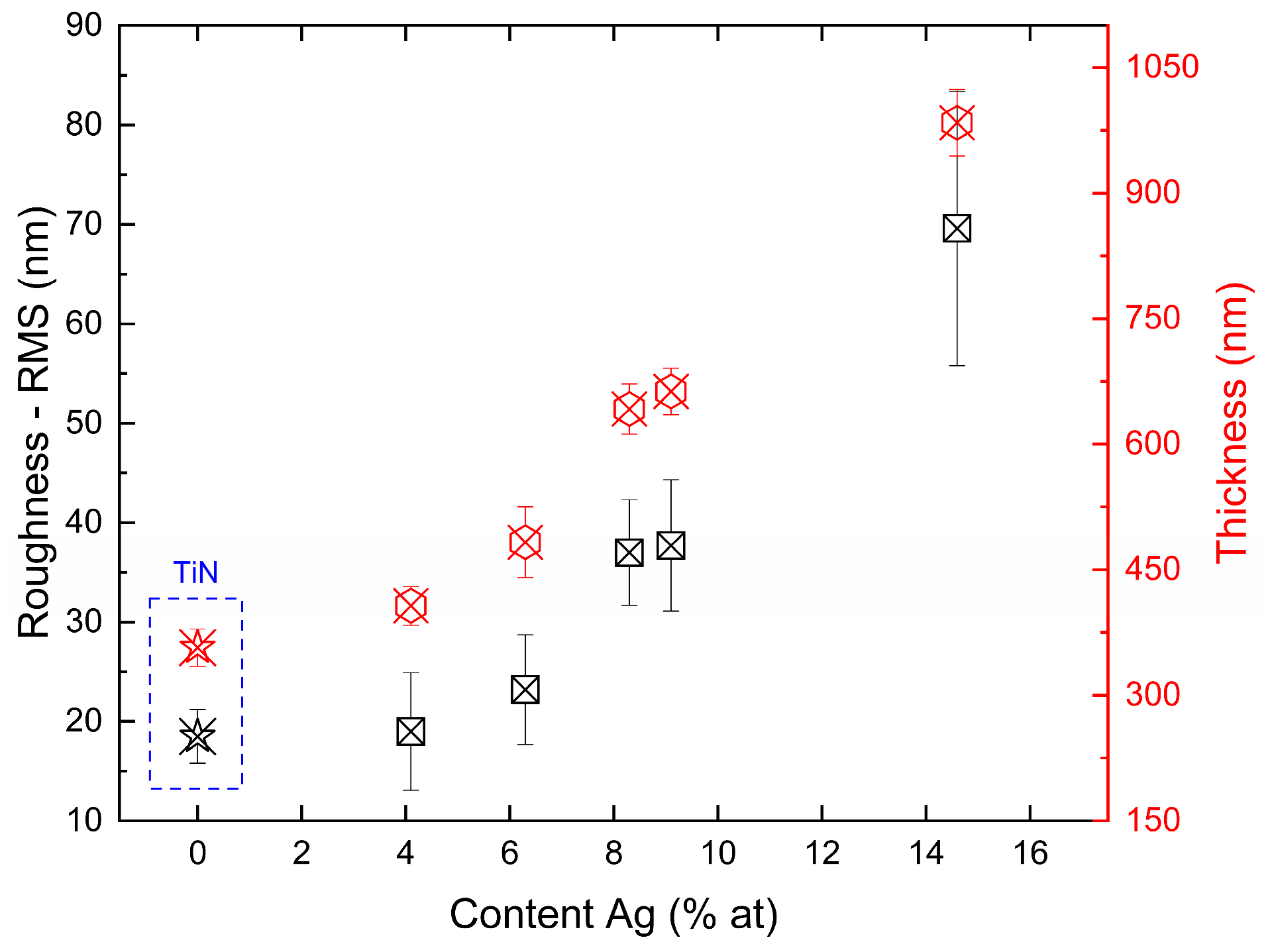
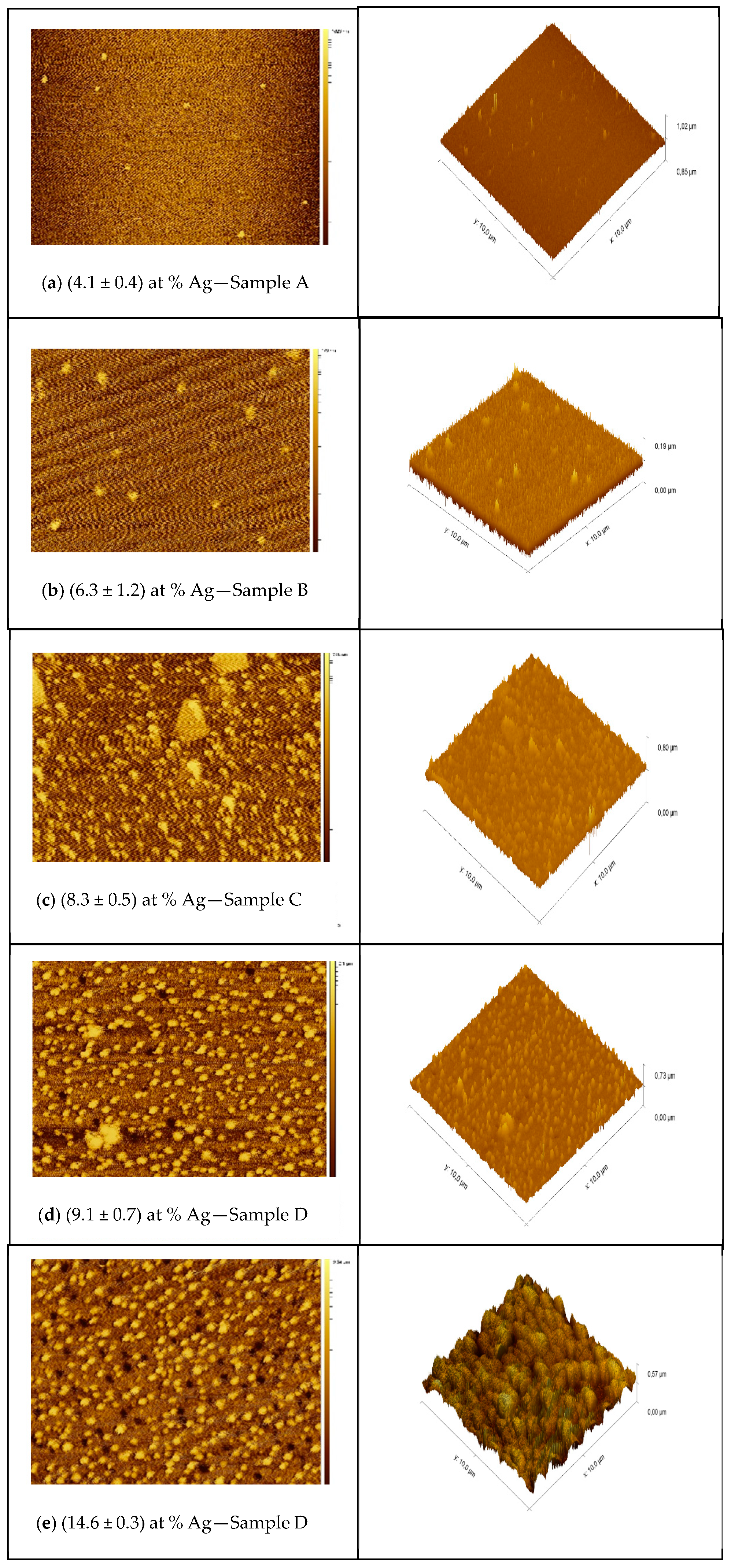

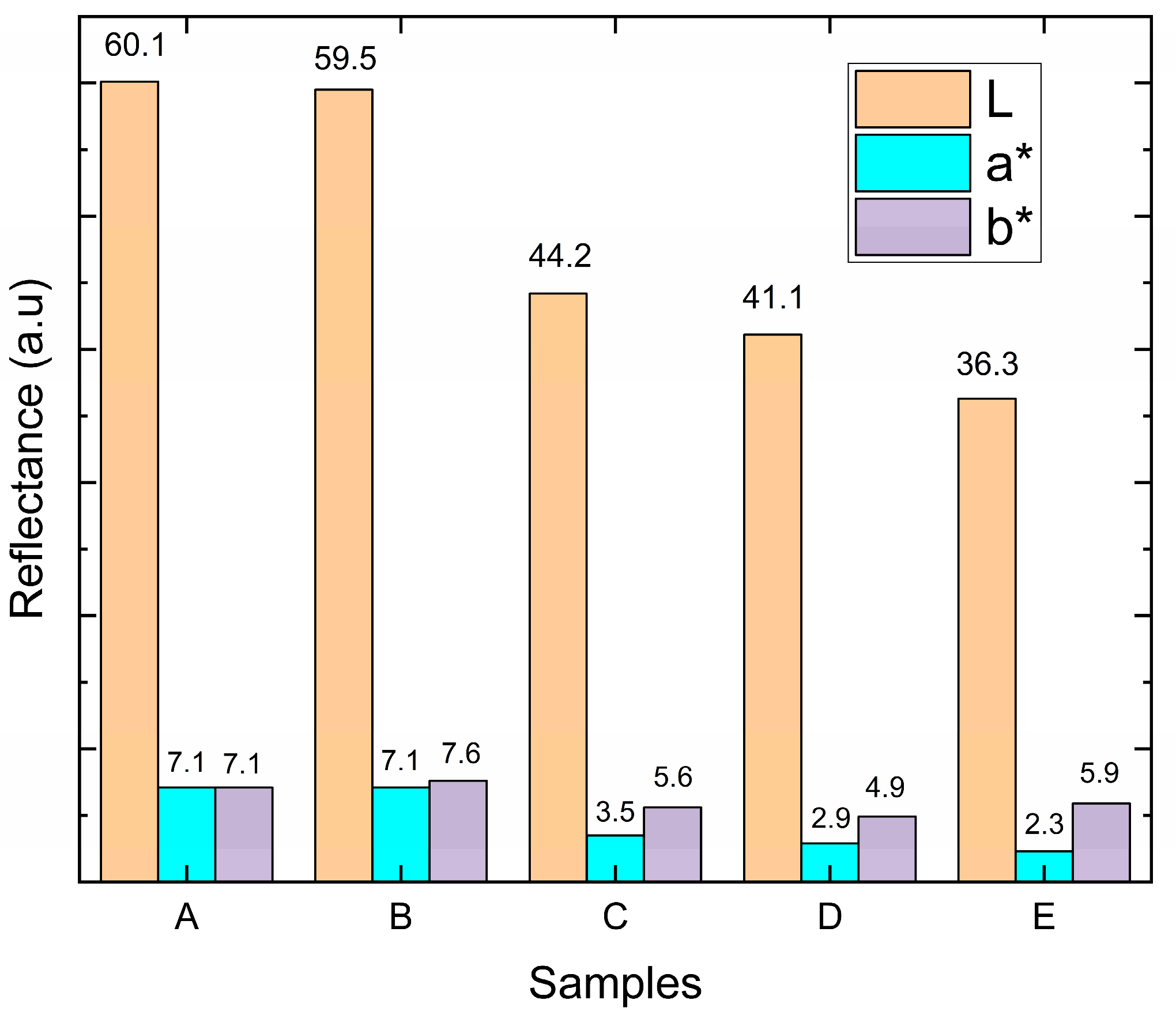
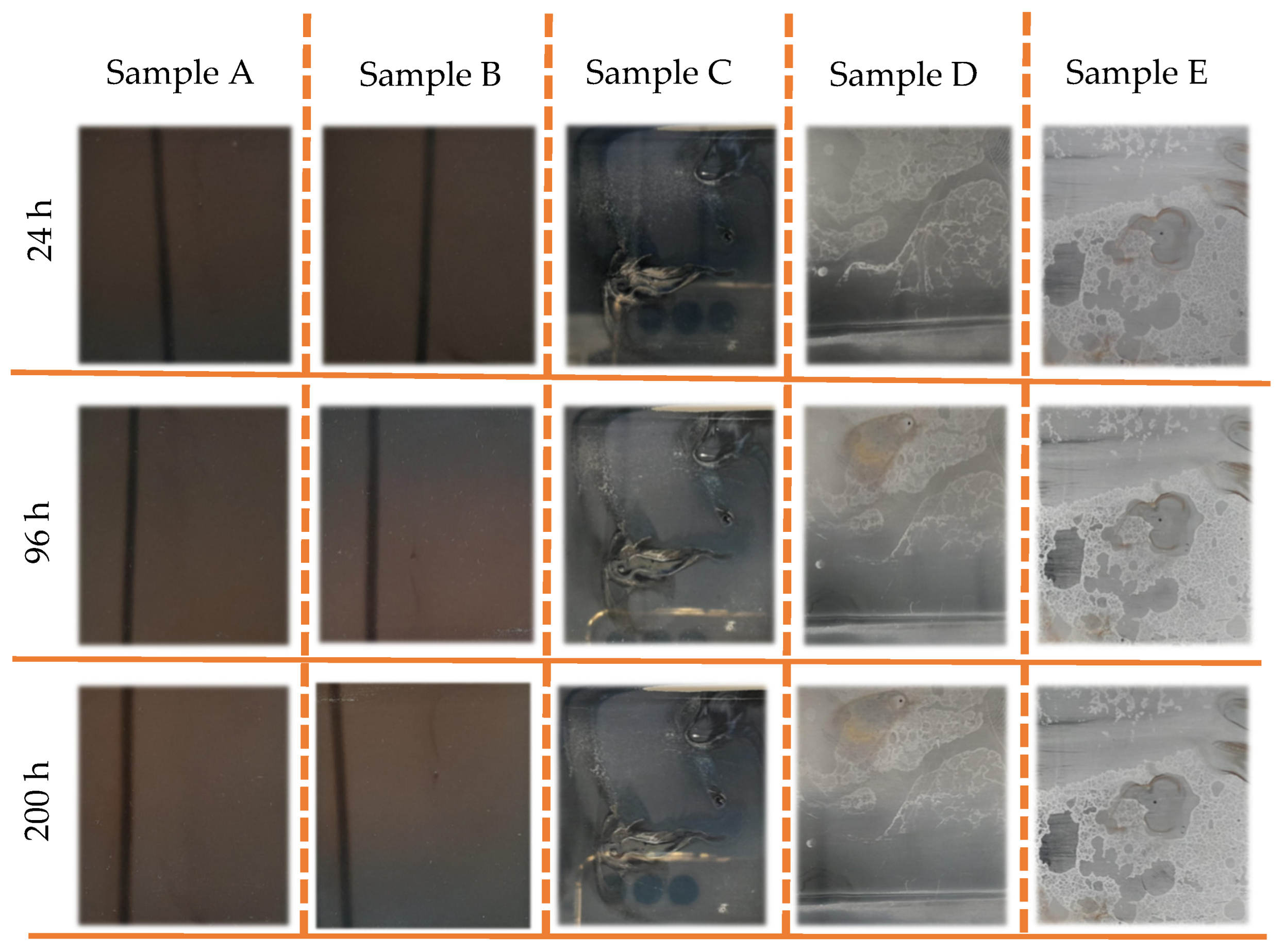
| Samples | Composition Ag at % | Composition N at % | Composition Ti at % | Ratio Ti/Ag |
|---|---|---|---|---|
| A | 4.1 ± 0.4 | 58.3 ± 0.9 | 37.6 ± 1.0 | 9.2 |
| B | 6.3 ± 1.2 | 59.1 ± 0.3 | 34.6 ± 1.2 | 5.5 |
| C | 8.3 ± 0.5 | 60.4 ± 0.9 | 31.3 ± 1.4 | 3.8 |
| D | 9.1 ± 0.7 | 59.3 ± 0.9 | 31.5 ± 1.5 | 3.5 |
| E | 14.6 ± 0.3 | 59.0 ± 0.5 | 25.4 ± 0.1 | 1.7 |
| Samples | Composition at % Ag | Roughness (RMS-nm) | Contact Angle (Degree) |
|---|---|---|---|
| A | 4.1 ± 0.4 | 19.0 ± 5.9 | 18.4 ± 9.3 |
| B | 6.3 ± 1.2 | 23.2 ± 5.5 | 44.9 ± 6.3 |
| C | 8.3 ± 0.5 | 37.0 ± 5.3 | 89.5 ± 1.9 |
| D | 9.1 ± 0.7 | 37.6 ± 6.6 | 89.4 ± 1.3 |
| E | 14.6 ± 0.3 | 69.6 ± 13.8 | 92.7 ± 1.4 |
Disclaimer/Publisher’s Note: The statements, opinions and data contained in all publications are solely those of the individual author(s) and contributor(s) and not of MDPI and/or the editor(s). MDPI and/or the editor(s) disclaim responsibility for any injury to people or property resulting from any ideas, methods, instructions or products referred to in the content. |
© 2024 by the authors. Licensee MDPI, Basel, Switzerland. This article is an open access article distributed under the terms and conditions of the Creative Commons Attribution (CC BY) license (https://creativecommons.org/licenses/by/4.0/).
Share and Cite
Arruda, A.C.S.d.; Mansano, R.D.; Ordonez, N.; Ruas, R.; Durrant, S.F. Ag Behavior on TiN Thin Films for Decorative Coatings. Coatings 2024, 14, 322. https://doi.org/10.3390/coatings14030322
Arruda ACSd, Mansano RD, Ordonez N, Ruas R, Durrant SF. Ag Behavior on TiN Thin Films for Decorative Coatings. Coatings. 2024; 14(3):322. https://doi.org/10.3390/coatings14030322
Chicago/Turabian StyleArruda, Antonio Carlos Santos de, Ronaldo Domingues Mansano, Nelson Ordonez, Ronaldo Ruas, and Steven Frederick Durrant. 2024. "Ag Behavior on TiN Thin Films for Decorative Coatings" Coatings 14, no. 3: 322. https://doi.org/10.3390/coatings14030322






